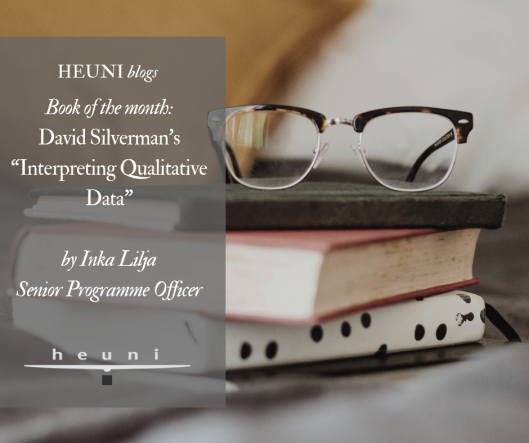Read your Silverman! Book recommendation by HEUNI staff

At the frontpage of www.heuni we claim that: "Our greatest strength is our capacity to develop multidisciplinary research methodologies and utilize them in order to explore new criminological phenomena." That sounds rather easy and smooth, but in reality, we at HEUNI struggle almost daily with methodological questions and practical problems related to data collection.
HEUNI does work with quantitative data, and the most downloaded HEUNI report ever is The European Sourcebook of Crime and Criminal Justice Statistics (Note! Vol. 6 coming out next year). However, in most of our projects we use qualitative data: qualitative data collected through interviews, focus groups, case studies, and media articles. Most recently we have collected data through journals, a novel methodology developed by HEUNI (more on this in the next HEUNI Highlights...).
Qualitative data is a mystery to many – including students or early career researchers, not to mention policy and decision makers – to whom most of HEUNI’s research is aimed at. Often statistics and numbers are seen to be more relevant and reliable than narratives. However, especially when researching hidden criminal phenomena, such as links between human trafficking and marriage or gender based violence against refugee women; both current research topics at HEUNI, one needs to look at individual cases, stories, behaviour, personal perceptions and even feelings. Though still, in order to be research, our endeavour must be based on a solid methodology. For anyone doubting the reliability of qualitative research, or not being familiar with it, I would recommend David Silverman’s “Interpreting Qualitative Data" (Sage publishing, 2014), the book of the month at HEUNI.
Silverman describes well many of the struggles qualitative researchers go through, all of them all too familiar to us at HEUNI: Where can we collect the data? Do we have access to the informants we would like to interview? Is there enough data available? Are we interpreting the data using the correct theoretical framework? Do we even have a theoretical framework? Is one case enough to say anything general about the phenomena? Did the respondents understand our question as we wanted them to understand it? Are we adding too much of our own interpretation to the informants’ interpretation of the situation? Are we being neutral? Silverman does have some reassuring answers, a wealth of examples and good critical questions, which each qualitative researcher can ponder in their respective chambers.
Lastly, Silverman gives an encouraging advice, which would resonate with any researchers struggling with too much data and too little time: “ Until you have analysed your data, you have achieved precisely nothing!" That’s quite reassuring, no?
